The Doom of “Oden”: Twilight of the Gods (Grimnir #2)
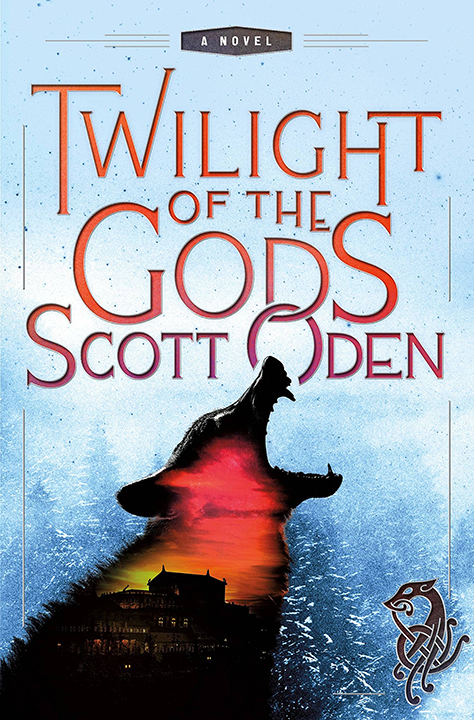 |
With Grimnir #2 Twilight of the Gods (TotG), Scott Oden presents a novel take on Ragnarök, the apocalypse in Norse mythology. He masterfully integrates his historical fiction expertise (i.e., from Memnon, Men of Bronze) with gritty battles reminiscent of Robert E. Howard (i.e., the creator of Conan the Barbarian; Oden recently published a serialized, pastiche novella across the Savage Sword of Conan Marvel Comic series). Few can merge the intensity of low-fantasy Sword & Sorcery with high-fantasy Epics, but Oden does here.
TotG is second in this series; Fletcher Vredenburgh reviewed Griminr #1 A Gathering of Ravens (AGoR) in 2017, and reported: “Oden tells a story that feels lifted straight from the sagas and Eddas.” This February, John O’Neill posted a Future Treasures to reveal the Jimmy Iacobelli cover art to Twilight of the Gods.
This article is a review of the story, the style, and the lore. Read on to learn about the series’ namesake, the apocalypse in this second volume, and get teasers for the third book, The Doom of Odin.
“Mark this, little bird: you can judge how high you stand in your enemy’s esteem by the weapon he draws against you.” – Grimnir
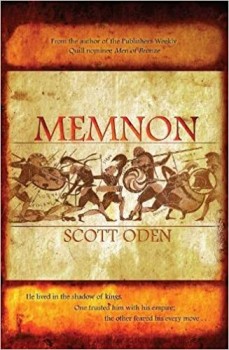 |
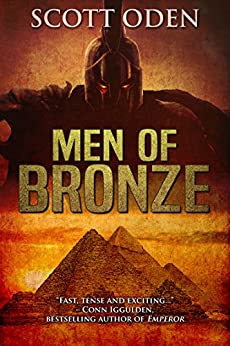 |
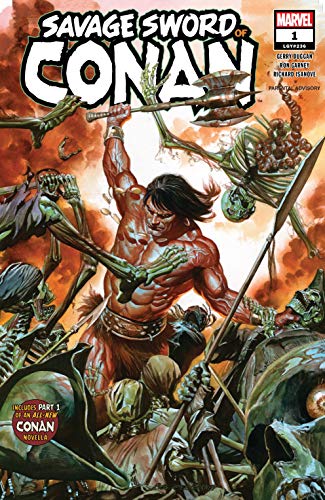 |
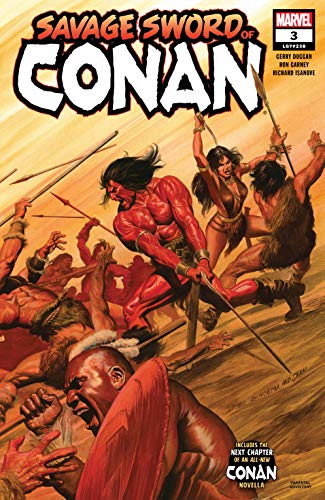 |
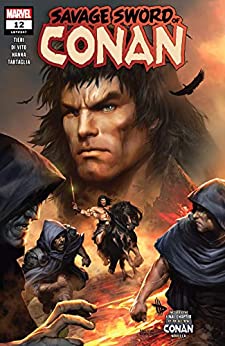 |
Odin Fades and the Cross Emerges
TotG blurs the line between fantasy and history.” With Odin losing power, the hymn-singers are stepping up to rule the world. The Christian commandment “Thou shalt not have strange gods before me” gave rise to much strife in real history, which even had converted Danes and Norsemen crusade for the Cross. The book opens with this conflict fueling Ragnarök (read Ch.1. online). These excerpts also capture Oden’s style, including Grimdark scenery:
Corpses sprawled atop a low hill, beneath a sky the color of old slate. They lay in their tattered war gear: mail riven, shields broken, and helmets split asunder by ferocious blows. There were scores of them, arranged not in the perfect windrows borne of clashing shield-walls, where the dead fall like grain beneath a thresher-man’s blade, but rather in heaps and mounds—as though the Tangled God himself, cunning Loki, had decided to reshape the land with the bodies of slain Northmen. Their blood mingled with other vital fluids, turning the early snow underfoot to a scarlet slurry.
A cold north wind moaned through the evergreen spruces ringing the hill. It rattled the shafts of spears that grew from bodies of the slain like corpse-flowers, their blades rooted in bellies and spines; it snapped the fabric of cast-off pennons. Some displayed a wolf’s head against a white field. Others, more numerous, bore a stark black cross. The wind faded; utter silence returned.
And… Howardian battle scenes:
Úlfrún did not flinch. She did not shy away from the whistling blade that sought to end her life. Instead, she stepped in and caught it on the knuckles of her iron fist. The sword sparked, rebounded; the clangor of impact reverberated. Far to the north, from among the cloud-wreathed peaks, came the echo of thunder as if in answer … The blade of her axe flashed in autumn’s pale light, and she rained blow after furious blow down upon the guard of her enemy. A rush of breath, a ringing crash, and the rasp and slither of steel on iron were the only sounds as she batted aside Heimdul’s clumsy riposte and very nearly took off his head. A hasty backward leap was all that saved him.
And… poetic horror:
And with a sound like the rattle of immense bones, the stranger’s cloak is borne up as by a hot breath of wind. There is only darkness, beneath. And that darkness grows and spreads, becoming monstrous wings that blot out the burning sky. The darkness crawls like a serpent across the ruin of Hrafnhaugr. It snuffs the flames and robs the air of its breath; it slays the living with a pestilence that rots the blood in their veins. It crushes and destroys. She turns to run as the darkness engulfs her. And in its hideous embrace, she opens her mouth to scream…
Via the current Goodreads Sword & Sorcery Groupread featuring this book, I learned from beta-reader Stan Wagenaar that this chapter was an intentional homage to REH’s Conan tale “Frost Giant’s Daughter” (1953, Fantasy Fiction). Between Étaín and Disa, Grimnir has sympathized with both sides of the religious war marking the end of the world (i.e., the Nailed-God versus the likes of Odin). Ultimately, he is out for his personal agenda, and there are plenty of antagonizing forces beyond human ones.
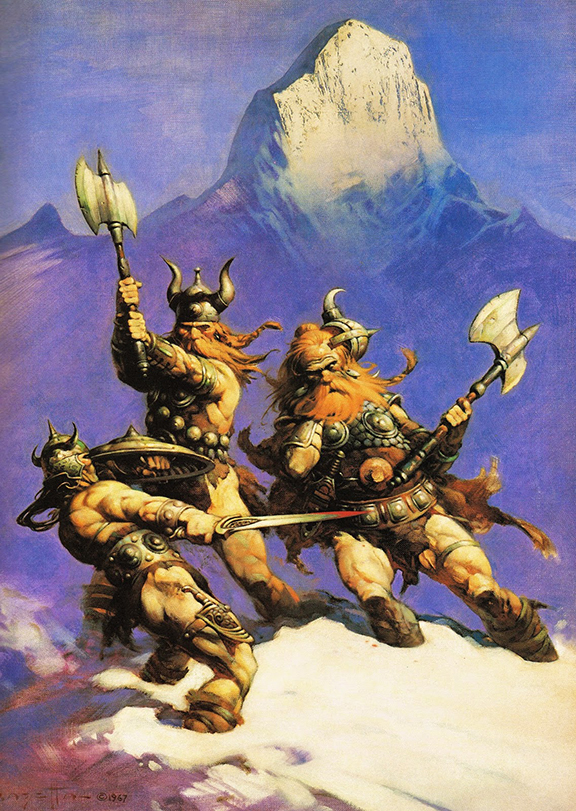 Frazetta, REH’s Frost Giant’s Daughter Frazetta, REH’s Frost Giant’s Daughter |
Who/What is Grimnir?
In the Beowulf saga, the titular hero hunts down the monstrous Grendel, then Grendel’s mother, then a dragon; the hero even becomes King of the Geats (the Geats of Scandinavia hailing from modern-day Sweden). TotG presents Grimnir as a demi-god hybrid of Beowulf & Grendel: half monster, half savior-to-be-worshipped) and king over the Raven-Geats no less! He has one working eye, but so do many suspicious characters ranging from Odin, a great wyrm, Nila, Grimnir, and the Grey Wanderer. So, you should not trust any one-eye, let alone Grimnr: he is a brutal bastard who is more out for self-preservation than for defending his human worshippers. He cares less about the threats of cross-bearing crusaders than he begrudges an ancient dragon—but more on wyrms below. TotG’s cursed crusader introduces us to Grimnir, emphasizing the various perspectives and clashes of cultures:
“Grimnir son of Bálegyr,” Konraðr said. “What a rough beast you are. You go by many names, I am told. Corpse-maker and Life-quencher, the Bringer of Night. Some claim you are the Son of the Wolf and Brother of the Serpent. The Irish called your kind fomoraig, did they not? They cursed your sire, Bálegyr, and the wolf ships that brought him to their fair isle. What did the English name you? Orcnéas? But to the Danes and the Norse your kind were always skrælingar. Accursed sons of Cain, you are …
Oden followers will note the “Orcneas” reference. The author has said: “Since young adulthood, I’ve wanted to write a book about Orcs—those foot soldiers of evil first revealed to us in The Hobbit and The Lord of the Rings by J. R. R. Tolkien. I wanted to write it from the Orcs’ point of view. And I wanted to redeem them.” Inspect the Russian cover to A Gathering of Ravens (inset) depicting Grimnir, albeit with a gratuitous beard. Oden concurs of his appearance on his blog while explicitly developing the lore: “I’ve seen that gets his hair right. Really, give him a sharper nose and there you have the last of the fabled kaunar, that blighted race of monsters who would enter popular culture centuries later as Tolkien’s Orcs.”
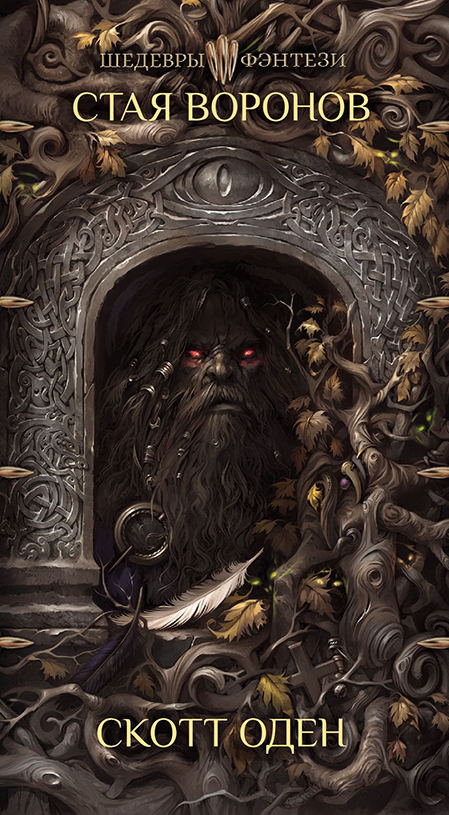 |
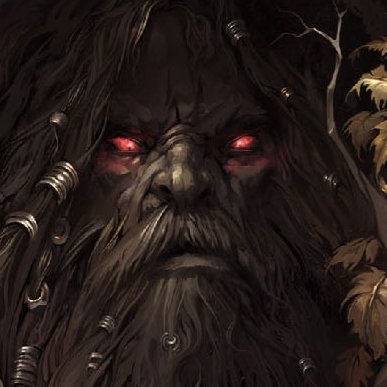 Russian cover art for A Gathering of Ravens, and zoomed-in depiction of Grimnir Russian cover art for A Gathering of Ravens, and zoomed-in depiction of Grimnir |
Grimnir’s Partner, Dísa Dagrúnsdottir:
Étaín was the young female protagonist in A Gathering of Ravens. This round, Grimnir’s partner is young Dísa (a.k.a. “Little Bird”, a Raven-Geat). Whereas Étaín was a Christian, Dísa is a barbaric, maiden of war—or she dreams to become one, anyway. Motherless, her clan selects her to confer with their godly protector the “Hooded One” (Grimnir). This book is really about her coming of age while the world ends; her priestess role puts her smack-dab on the intersection of the corporeal and the supernatural. Disa is a likable, spirited character that you will be rooting for from the instant she is presented in chapter two.
[Disa], who springs from the loins of Dagrún Spear-breaker; she, who is a Daughter of the Raven, bearer of the rune Dagaz; she, who is the Day-strider, chosen of the Gods. She, who is skjaldmær, shieldmaiden.
A contemporary similar character would be Sensua from the acclaimed Ninja Theory video game series Hellblade (Sensua’s Sacrifice (2017) followed by Sensu’s Saga due out 2020). This January, S.M. Carrière posted on the sequel’s video trailer featuring the band Heilung. In short, if you like Sensua or Heilung, then you must experience Disa’s saga. The embedded video could easily be repurposed as a trailer for Dísa in TotG:
Serpents & Dragons:
In Norse mythology, Ragnarök is triggered by the world (Midgard)-wrapping serpent Jörmungandr releasing the tail from its mouth, and uncoiling. So, readers should expect some form of dragon and we are gifted the spawn of the legendary Jormungandr’s (Midgard Serpent): Malice-Striker. The combination of lore and prose reinforcing Malice-Striker’s presence evokes classic dragons, such as Beowulf’s foe or J.R.R.’s Glaurung (the Worm of Morgoth/Angband from the Children of Hurin). Malice-Striker’s character and past are revealed, and [minor spoiler] he is set up for a key role in the next installment.
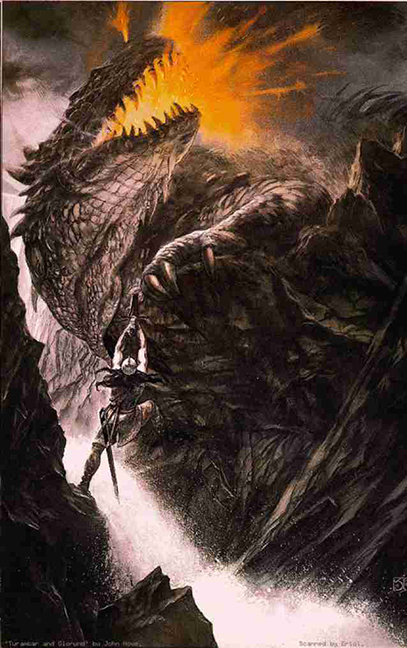 |

Alan Lee depicts Glaurun’s eye (top) John Howe depicts Tolkien’s Glaurung (left) |
The Doom of Odin (Grimnir series #3)
Twilight of the Gods delivered an apocalyptic nail-biter. It can be read completely stand-alone, but certainly builds on A Gathering of Ravens. Still the battle rages on for Grimnir. Oden plans to finish the third installment, The Doom of Odin, by the end of summer 2020 (publication at St. Martin’s discretion). From the author’s website, we find the likely book blurb:
As the Black Death rampages across Europe, two creatures of the Elder World clash over the rotting corpse of Christendom …
Sicily, 1347 AD. A ghost ship from the east washes ashore at Messina. A ship of dead men, and hidden in its belly is a doom like no other: the dragon Niðhöggr, the Malice-Striker, an ancient vessel of destruction from the Elder Days. And while it is no longer the mighty wyrm of Ragnarök, the beast’s breath still bears upon it a pestilence, a plague that will echo through the ages as the Black Death.
But the world of Men has a strange champion – another creature of the Elder World: a snarling, spitting knot of hatred, profane and blasphemous, whose ancestors were the goblins of myth and legend; he is a monster in truth, though nevertheless he stands as the last bastion between humanity and the cold silence of oblivion. He is Grimnir, and he has hunted the Malice-Striker for more than a century, from the cold wastes of the Baltic to the dank cisterns beneath Constantinople.
Now, as the plague stalks through Western Europe – and as the dread wyrm slithers through Italy, bound for Rome on its mission to devour the head of Christendom – Grimnir must contend not only with the beast’s insidious cunning, but with the iron fist of the Papal Inquisition, and the army of a vengeful Italian condottiere. Grimnir, however, is not without allies of his own. Accompanied by a Jewish witch and mystic, and aided by the fey King of the Mongrel Court, a troupe of half-blooded creatures bound for Finisterre and the World’s End, Grimnir sets the stage for a final showdown.
For at Avignon, the papal enclave on the River Rhone, the Doom of Odin will fall, and the Elder World will finally meet its bloody end. The only question that remains is: will Miðgarðr and the world of Men survive this deadly clash of titans?
On Scott Oden
Scott is the author of five novels, two historical fiction (Men of Bronze and Memnon), three fantasy with a strong historical bent (The Lion of Cairo, A Gathering of Ravens, and Twilight of the Gods), and a collaborative novel (A Sea of Sorrow: A Novel of Odysseus). He is the author of the Robert E. Howard pastiche Conan novella “The Shadow of Vengeance”, serialized in issues #1-#12 of Marvel’s The Savage Sword of Conan, as well as the Conan short story “Conan Unconquered”, appearing in the video game of the same name. In addition, he has written a couple of short stories, and a few non-fiction articles and introductions (notably, the introduction to Del Rey’s Robert E. Howard collection, Sword Woman and Other Historical Adventures). He has been an avid tabletop role-playing gamer since 1979, beginning with Holmes-edition D&D. Scott was born in Columbus, Indiana, but was raised in rural North Alabama, near Huntsville. He currently splits his time between his home in Alabama, a Hobbit hole in Middle-earth, and some sketchy tavern in the Hyborian Age.
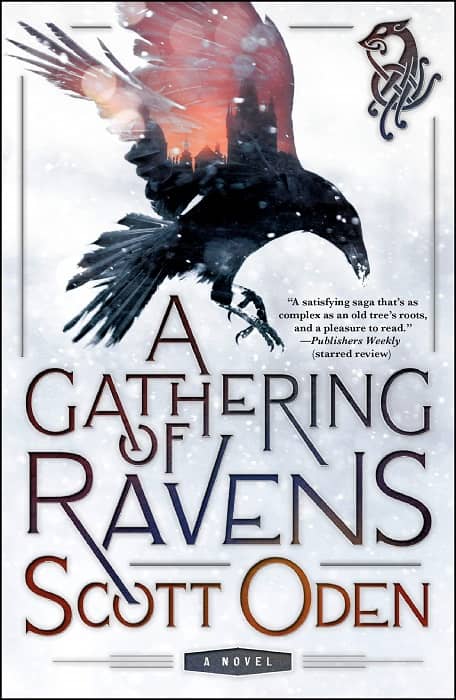 |
 |
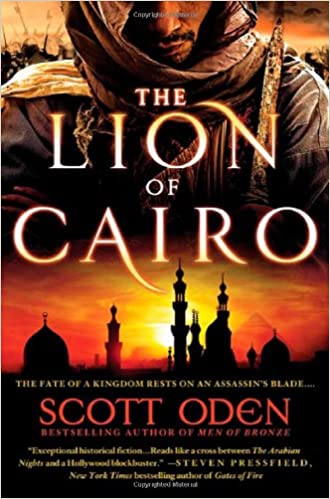 |
S.E. Lindberg resides near Cincinnati, Ohio working as a microscopist by day. Two decades of practicing chemistry, combined with a passion for the Sword & Sorcery genre, spurs him to write adventure fictionalizing the alchemical humors (under the banner Dyscrasia Fiction). With Perseid Press, he writes weird tales in the same vein (Heroika and Heroes in Hell series). He co-moderates the Sword & Sorcery group on Goodreads, and invites all to participate. He enjoys studying Aikido and creates all sorts of fine art in the family workshop. Touch base via Facebook or Twitter.